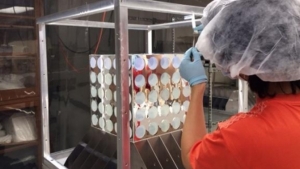

University of Hawaiʻi at Mānoa researchers will receive federal funding to develop and demonstrate new technologies that advance nuclear nonproliferation. As members of two new university consortia on the cutting edge of nuclear nonproliferation efforts, scientists from the UH Mānoa School of Ocean and Earth Science and Technology (SOEST) and the College of Natural Sciences, have been awarded $3.2 million from the Department of Energy’s National Nuclear Security Administration (DOE/NNSA) during the five-year projects.
The consortia will also help build the nuclear security workforce, with participating postdoctoral fellows and graduate students partaking in research and internships at National Laboratories. Efforts throughout the consortia will link basic research at universities with the capabilities of the National Laboratories to advance nuclear science and security goals.
“These grants will foster development of concepts and technologies that keep the United States at the forefront of nuclear monitoring and verification capabilities and allow us to nurture tomorrow’s nonproliferation experts,” said Brent K. Park, NNSA’s deputy administrator for defense nuclear nonproliferation.
The Consortium for Monitoring, Technology and Verification (MTV), led by the University of Michigan, brings together 14 universities and 13 national laboratories to demonstrate new ways to monitor, detect and identify violations of nuclear treaties. At UH Mānoa, Milton Garces, researcher in SOEST’s Hawaiʻi Institute of Geophysics and Planetology (HIGP), is the MTV principal investigator and team leader for monitoring physics. UH Mānoa Earth sciences associate professor Henrietta Dulai and physics professor John Learned are co-investigators.
The second consortium, Enabling Technologies and Innovation (ETI), led by the Georgia Institute of Technology, consists of a cohort of 12 universities and 10 national laboratories that will focus on computer and engineering science research in machine learning, advanced manufacturing and disruptive detection technologies for nonproliferation. In his role as ETI outreach director for technology, Garces will also facilitate cross-cutting research between the labs and universities and help assess the practicality and transferability of university research.
“These are excellent opportunities to initiate and extend scientific collaborations as well as help train a new generation of scientists and technicians that can help us build a better, safer world,” said Garces. “The false missile alert of January 2018 was a stark reminder of Hawaiʻi’s vulnerability on the Western front. Our mission is to help build, demonstrate, transfer and support technology and know-how that can prevent that scenario from actually happening.”
“Our participation in two of the winning consortia provides more national recognition of the superb research capability at UH Mānoa,” said UH President David Lassner. “This is a great example of how our faculty are working every day to make the world safer for all of us.”
UH consortia projects
Antineutrino monitoring for nonproliferation
Reading time: 4 minutes
Within the MTV consortium, Learned will improve our understanding of antimatter and how it can contribute to nonproliferation verification. Antineutrinos are tiny, high-energy particles that are produced by numerous sources including nuclear materials, reactors and detonations, and cannot be shielded or disguised. Learned’s team aims to improve antineutrino detectors by reducing their size and improving sensitivity, which will allow monitoring stations to precisely locate possible nuclear activities.
“Our involvement in this exciting project is leveraged by our group’s technical expertise and past experience in near-reactor detection, along with our present involvement with the NNSA WATCHMAN project that will build a long-range prototype neutrino detector for anti-proliferation purposes,” said Learned.
Studying how nuclear activities interact with organisms
Reading time: 4 minutes
Materials released from nuclear activities, including radionuclides, also interact with plants, animals and microorganisms in the soil and ocean—leaving unique signatures. Dulai will explore the applicability of selected organisms as recorders of past nuclear events. Dulai and her team will target selected organisms to explore how geographically unique terrestrial and marine biota on Pacific Islands responded to radionuclides from a past nuclear events, such as the 2011 Fukushima Daiichi Nuclear Power Plant accident.
“The impact of the project will be the development of radionuclide inventory and distribution in islands of the Pacific Ocean in specific indigenous biota as well as documentation of physiological changes related to the presence of radionuclides,” said Dulai. “This will aid the development of future targeted techniques to monitor radionuclides. In addition, this project will develop new radiochemical techniques and measurement methods useful for environmental monitoring.”
Enhancing global monitoring
Reading time: 4 minutes
Garces leads the HIGP Infrasound Laboratory, where over the last 20 years they have developed technology to monitor deep, inaudible atmospheric sound produced by extreme natural events, such as volcanoes and asteroid impacts, and intense explosions. These deep sounds travel through the atmosphere for thousands of miles, and can be used to detect possible explosive nuclear tests from afar.
As part of the new MTV project, Garces’ team will explore new techniques for using infrasound to estimate the location and intensity of anomalous sound sources in the atmosphere or near the earth surface.
“Legacy infrasound sensor systems are large, expensive, and limit our ability to rapidly collect critical data,” said Garces. “As a part of these consortia, we will significantly expand existing capabilities to detect and analyze infrasound using ubiquitous sensors, such as smartphones.”
Under the ETI, Garces will build on the RedVox Recorder smartphone app first conceived at UH. Garces proposes to build and maintain an open-source RedVox Software Development Kit that will facilitate data acquisition and analysis by collaborators. He also plans to develop procedures for constructing machine learning training sets from these heterogeneous data—all in an effort to enhance and improve nonproliferation monitoring capabilities.

